Projekter
På Statens Naturhistoriske Museum forsker vi i systematik, fylogeni og udviklingshistorie af forskellige organismegrupper. Vi beskriver nye arter og undersøger deres biologi og udbredelseshistorie. Vi anvender metoder som molekylær fylogeni og eDNA, scanning elektron mikroskopi, synchrotron scanning og radiometrisk datering.
Vores forskning tager udgangspunkt i vores store samlinger, der løbende suppleres med materiale indsamlet i forbindelse med vores projekter. Hvis du har en idé til et projekt du kunne tænke dig at lave, eller særlig interesse for en gruppe eller metodik, så prøv at kontakte nogen af vores forskere der vil kunne vejlede dit projekt.
Nedenfor kan du se eksempler på projekter udført på Statens Naturhistoriske Museum for nylig.
Projektet sammenligner traditionel indsamling af insekter med malaisefælder med automatiseret datamonitorering baseret på udslag fra flyvende insekters vingeslagsfrekvens i et elektriske felt langs en miljøgradient fra eng til mark. Desuden undersøges biodiversitetsmønstre langs gradienten med biller (Coleoptera) som biodiversitetsindikator.
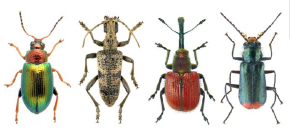 Malaisefælder og sensorer blev placeret parvis på fire lokaliteter med 80 meters afstand i et 240 meter transekt. Alle biller blev talt og artsbestemt, og diversiteten blev analyseret med hensyn til artsrigdom, similaritet og artsfordeling. I alt blev 93 arter registreret, med den højeste artsrigdom på marken. Similariteten i artsammensætningen viste ingen tydelig sammenhæng med afstanden fra engen, mens evenness for biller var højere på engen end på marken.
Malaisefælder og sensorer blev placeret parvis på fire lokaliteter med 80 meters afstand i et 240 meter transekt. Alle biller blev talt og artsbestemt, og diversiteten blev analyseret med hensyn til artsrigdom, similaritet og artsfordeling. I alt blev 93 arter registreret, med den højeste artsrigdom på marken. Similariteten i artsammensætningen viste ingen tydelig sammenhæng med afstanden fra engen, mens evenness for biller var højere på engen end på marken.
Analyse af korrelationen mellem data fra malaisefælder og sensorer viste ingen sammenhæng mellem individantal og biomasse. Flere faktorer adskiller de to registreringsmetoder og gjorde sammenligningen vanskelig. Sensorerne registrerede generelt flere individer og højere biomasse, og med deres standardiserede metode, lave behov for tilsyn og minimal databehandling kan de udgøre en effektiv løsning til langtidsmonitorering af flyvende insekter.
Vejleder: Thomas Pape
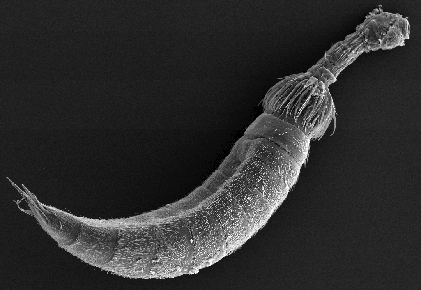 A majority of the microscopic animal fauna remains undiscovered and undescribed. Based on specimens from the Natural History Museum of Denmark collections, and new species of the microscopic animal group Kinorhyncha (mud dragons) from Micronesia was described.
A majority of the microscopic animal fauna remains undiscovered and undescribed. Based on specimens from the Natural History Museum of Denmark collections, and new species of the microscopic animal group Kinorhyncha (mud dragons) from Micronesia was described.
The description was based on combined data from different microscopic methods, including Differential Interference Contrast Microscopy and Scanning Electron Microscopy. The project was composed as a scientific manuscript, and was subsequently published in an international scientific journal.
Student: Alexis Detlov Moreleon
Supervisor: Martin V. Sørensen (mvsorensen@snm.ku.dk)
This project provides a thorough morphological description of several females and a few males of Menneus tetragnathoides Simon, 1876 collected in the Udzungwa Mountains National Park and the Uzungwa Scarp Forest Reserve, Tanzania. These spiders belong to the rare family Deinopidae and are known for the unique behavior of thrusting their small cribellate webs over nocturnal aerial and ground-dwelling prey.
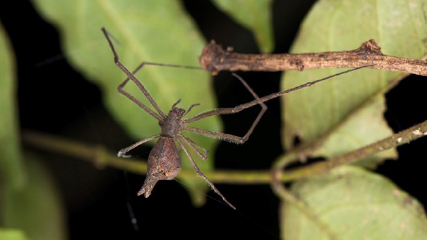 An updated character matrix for all species of Menneus Simon, 1876 is analyzed, and the resulting phylogenetic tree is discussed. No strong morphological marker justifies a separation between M. darwini Coddington, Kuntner & Opell, 2012 and M. tetragnathoides Simon, 1876, and the names are proposed to be synonyms.
An updated character matrix for all species of Menneus Simon, 1876 is analyzed, and the resulting phylogenetic tree is discussed. No strong morphological marker justifies a separation between M. darwini Coddington, Kuntner & Opell, 2012 and M. tetragnathoides Simon, 1876, and the names are proposed to be synonyms.
Supervisor: Nikolaj Scharff
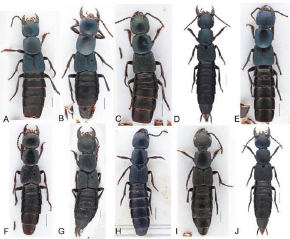 What is a species is a fundamental biological problem without an easy answer. Using integrative taxonomy approach, such as comparative morphology of external characters and genitalia and DNA barcoding, this PUK explored the variation of a large European rove beetle Ocypus ophthalmicus. It turned out this species consists of a complex of cryptic species, only some of which can be distinguished morphologically.
What is a species is a fundamental biological problem without an easy answer. Using integrative taxonomy approach, such as comparative morphology of external characters and genitalia and DNA barcoding, this PUK explored the variation of a large European rove beetle Ocypus ophthalmicus. It turned out this species consists of a complex of cryptic species, only some of which can be distinguished morphologically.
However, for some populations mtDNA used for barcoding also gave ambiguous result suggesting Wolbachia infection or some other processes that cause DNA variation not connected to speciation. The PUK laid the foundation for a bigger study and description of new species.
Supervisor: Alexey Solodovnikov
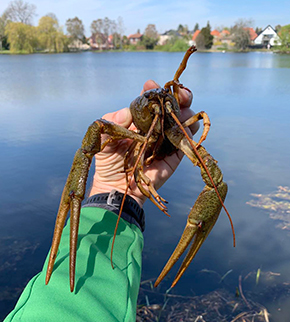 eDNA monitoring of aquatic life has become a successful tool for surveying the distribution and status of a wide range of organisms. This includes freshwater crayfishes, that are represented in Denmark with both a rare, threatened species and two invasive species. The methods are still being optimized and are often used in combination with other methods.
eDNA monitoring of aquatic life has become a successful tool for surveying the distribution and status of a wide range of organisms. This includes freshwater crayfishes, that are represented in Denmark with both a rare, threatened species and two invasive species. The methods are still being optimized and are often used in combination with other methods.
MSc project: J.M. Lyngsøe
Supervisor: Peter Rask Møller
The Arctic region is experiencing accelerated climate changes, with temperatures increasing nearly four times faster than the global average. This impacts marine ecosystems as e.g. the intensity of algae blooms seems to be increasing. Blooms can be harmful if toxic-producing species proliferate.
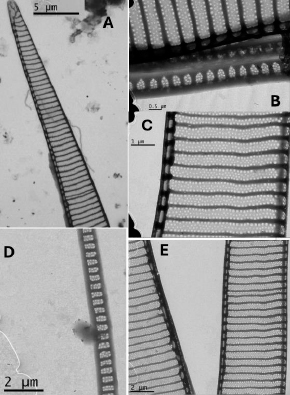 Species within the genus Pseudo-nitzschia are of interest, as species are known to produce the neurotoxin domoic acid (DA). This study focuses on diatom cultures collected from Disko Bay in West Greenland. Using transmission electron microscopy (TEM) and DNA sequencing, strains were identified and analyzed, revealing three Pseudo-nitzschia species - P. seriata, P. obtusa, and P. arctica. P. seriata emerged as the most abundant species, found in both high and low Arctic waters.
Species within the genus Pseudo-nitzschia are of interest, as species are known to produce the neurotoxin domoic acid (DA). This study focuses on diatom cultures collected from Disko Bay in West Greenland. Using transmission electron microscopy (TEM) and DNA sequencing, strains were identified and analyzed, revealing three Pseudo-nitzschia species - P. seriata, P. obtusa, and P. arctica. P. seriata emerged as the most abundant species, found in both high and low Arctic waters.
It is known to produce domoic acid (DA) and in this study, several strains tested positive for DA and its isomers. P. seriata seem to have the ability to adapt to future changes, potentially leading to a wider distribution in the Arctic. This is concerning, as toxin production has been found to increase with increasing temperatures that are expected to become more prevalent in the Arctic due to climate changes.
Bachelorproject: Anne Cathrine Jensen
Supervisor: Nina Lundholm
An interest in toxic microalgae combined with an unsolved mass mortality event of harbour seals and harbour porpoises in Denmark in 2007, initiated a bachelor project exploring whether presence of toxic algae and their toxins could explain the death of marine mammal in 2007.
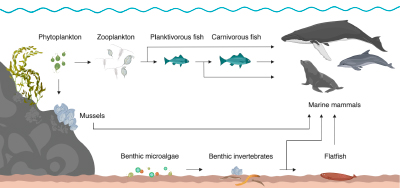 Tissue samples from deceased seals were gathered from Danish collaborators and screened for a suite of algal toxins, as toxic harmful algal blooms (HABs) are increasing worldwide and known to affect marine mammals and because toxic algae occur in Danish waters. This was combined with a study of survey data of microalgae from the Environmental Ministry from Danish waters before, during, and after 2007. The study revealed that certain algal toxins may have played a role in the mammal death in 2007.
Tissue samples from deceased seals were gathered from Danish collaborators and screened for a suite of algal toxins, as toxic harmful algal blooms (HABs) are increasing worldwide and known to affect marine mammals and because toxic algae occur in Danish waters. This was combined with a study of survey data of microalgae from the Environmental Ministry from Danish waters before, during, and after 2007. The study revealed that certain algal toxins may have played a role in the mammal death in 2007.
Ida-Marie Mollerup og Juni Bjørneset
Supervisors: Nina Lundholm og Morten Tange
The Gram clay has long been known as an important deposit for the study of Miocene fossil whales with both toothed and baleen species being recovered, including a number of crania and partial skeletons. Whilst these specimens are impressive and important for the study of whale evolution, they are not common, with most finds being isolated bones.
Isolated bones, as they are generally difficult to identify, have usually been left out of studies, however they still contain important information about the diversity, population and distribution of whales in both space and time. This project used a collection of Miocene isolated bones (namely vertebrae) from the Natural History Museum of Denmark and Museum Sønderjylland to add to our overall understanding of whale diversity through the Miocene.
The 2010 Deepwater Horizon (DWH) oil spill released 4.0 million barrels of petroleum into the Northern Gulf of Mexico (NGoM), causing a substantial Marine Oil Snow, Sedimentation and Flocculent Accumulation (MOSSFA) event. Benthic foraminifera have successfully been used as bioindicators of the event with an 80–93% decline in density coinciding with the oil spill, followed by a recovery period to a steady state within three to five years.
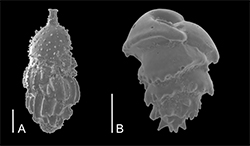 This project studied the size and morphological of four species of benthic foraminifera which remained abundant through the DWH oil spill (Uvigerina peregrina, Brizalina subaenariensis var. mexicana, Bulimina marginata and Cassidulina teretis) to understand how different species were impacted and why such a loss in density occurred. Short-lived radioisotope dating distinguished the pre-DWH and post-DWH depth intervals from 2010 to 2015. The species showed shape changes in response to the oil and MOSSFA processes and the pre-DWH length/width ratios of Uvigerina peregrina and Brizalina subaenariensis var. mexicana were significantly different than post-DWH length/width ratios within the cores.
This project studied the size and morphological of four species of benthic foraminifera which remained abundant through the DWH oil spill (Uvigerina peregrina, Brizalina subaenariensis var. mexicana, Bulimina marginata and Cassidulina teretis) to understand how different species were impacted and why such a loss in density occurred. Short-lived radioisotope dating distinguished the pre-DWH and post-DWH depth intervals from 2010 to 2015. The species showed shape changes in response to the oil and MOSSFA processes and the pre-DWH length/width ratios of Uvigerina peregrina and Brizalina subaenariensis var. mexicana were significantly different than post-DWH length/width ratios within the cores.
Reduced oxygen levels were likely a long-term (3–5 years) driver of this shape change and enhanced organic carbon concentrations were a short-term (1–2 years) driver. The project demonstrated the importance of the benthic foraminiferal morphological response to the DWH oil spill and furthers our understanding of the strategies of taxa that occurred abundantly throughout the record.
DNA barcoding and metabarcoding has a wide range of applications in ecological research, but a high-quality DNA barcode reference library with an extensive species coverage is the foundation. The financial and time commitment required to create DNA barcode reference libraries acts as a limitation on the creation of these resources.
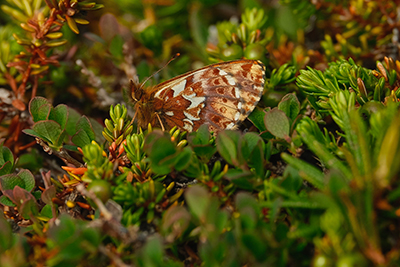 Here, we have attempted a low- cost yet highly effective approach to assembling a reference library of flowering plant DNA barcodes, by curating existing DNA barcodes from open-access databases and supplementing them with sequences generated from freshly collected Greenlandic plants. We have successfully created a DNA barcode reference library using rbcL, ITS2 and matK that includes 5859 DNA barcodes for 82% of the Greenlandic flora.
Here, we have attempted a low- cost yet highly effective approach to assembling a reference library of flowering plant DNA barcodes, by curating existing DNA barcodes from open-access databases and supplementing them with sequences generated from freshly collected Greenlandic plants. We have successfully created a DNA barcode reference library using rbcL, ITS2 and matK that includes 5859 DNA barcodes for 82% of the Greenlandic flora.
MSc project, performed by Zhao-Li under the supervision of Natasha de Vere
Myreløver (Neuroptera: Myrmeleontida) er store smukke insekter; deres grimme larver graver tragte i sand til at fange insekter i. Der findes kun tre arter Danmark og de har meget pletvis udbredelse: Bornholm (Dueodde), Læsø, Skagen og Asserbo Plantage (Nordsjælland) er de vigtigste lokaliteter.
 Myreløvernes udbredelse blev kortlagt ved registrering af materiale i samlingerne på Statens Naturhistoriske Museum og Naturhistorisk Museum, Aarhus. Ved at sammenligne udbredelsen med et geomorfologisk kort over Danmark kunne det påvises at myreløver her i landet kun har populationer hvor der er flyvesand, som er optimalt for larverne at lave tragte i.
Myreløvernes udbredelse blev kortlagt ved registrering af materiale i samlingerne på Statens Naturhistoriske Museum og Naturhistorisk Museum, Aarhus. Ved at sammenligne udbredelsen med et geomorfologisk kort over Danmark kunne det påvises at myreløver her i landet kun har populationer hvor der er flyvesand, som er optimalt for larverne at lave tragte i.
Studiet er siden publiceret som https://doi.org/10.1080/00222933.2022.2028029
- BSc projekt, Nicholas Hüsig Petersen
- Vejleder: Lars Vilhelmsen
